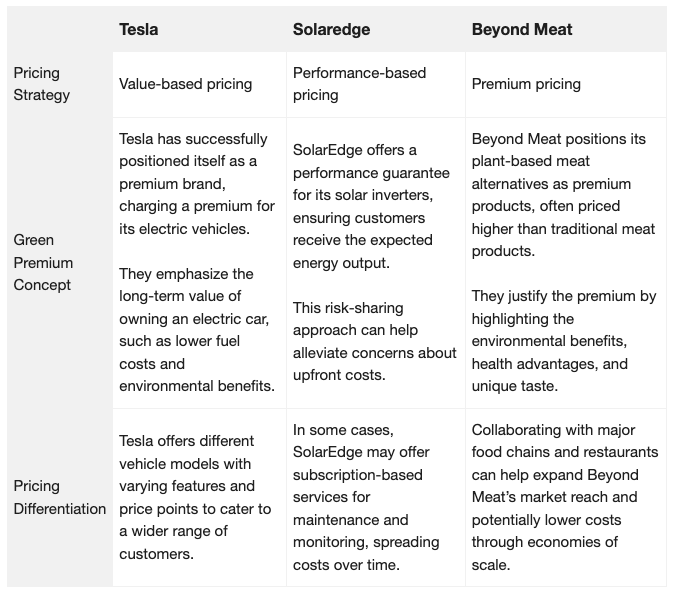Struggling with pricing your green tech innovation? You’re not alone. Balancing profitability, market adoption, and sustainability can feel like solving a complex puzzle.
Determining a green tech pricing approach is a balancing act that goes far beyond setting a number. For startups offering innovative, sustainability-focused technologies, pricing can determine success or failure. Yet, it remains one of the most complex challenges.
Pricing challenges for green tech startups
Unlike traditional markets, green tech startups operate in a landscape shaped by high R&D costs, evolving customer expectations, and a growing demand for environmentally-friendly solutions. While customers and investors are increasingly prioritizing sustainability, they also expect competitive pricing — a tension often referred to as the “green premium.”
“Around one in three consumers have a higher willingness to pay for sustainable products, with an estimated average premium of 25% on their last sustainable purchase” [1]
his study from Deloitte provides insights into the willingness of consumers to pay, and, even though not fully correlated, B2B buyers are also typically more willing to pay for planet-loving solutions.
Adding to this complexity is the task of educating the market. Many potential customers don’t fully understand the long-term value of green tech solutions or the environmental and social benefits they deliver. As a result, startups must not only set prices, but also effectively communicate the value of their solutions.
Moreover, the perception of cost can become a barrier to adoption. The upfront expense of innovative technologies, even when offset by long-term savings, may deter risk-averse buyers. This makes it crucial to explore creative pricing models that reduce barriers while aligning with customer priorities.

How to approach pricing as a green tech startup
Based on our experience and various projects, here’s how to make pricing work effectively:
Focus on the value your innovation provides rather than costs alone. This is especially important in green tech, where the benefits often extend beyond direct financial gains.
- Highlight long-term cost savings
(e.g., energy efficiency, reduced waste, lower operational costs). - Quantify environmental and social impact
(e.g., carbon footprint reduction, compliance with ESG goals). - Tailor pricing to specific customer needs
Showing how your product addresses their pain points better than alternatives.
While many green tech products are perceived as more expensive than conventional options, startups can counteract this by communicating the “green premium” effectively:
- Emphasizing total cost of ownership (TCO)
Over the product lifecycle, showing how it’s cheaper in the long run. - Tying pricing to intangible benefits
Such as brand reputation, meeting regulatory requirements, or aligning with ESG standards. - Positioning the “green premium” as an investment in sustainability and innovation
Appealing to customers’ values and strategic priorities.
Innovation around technology and products is critical, but the innovation or use of different pricing models can also help reduce barriers to adoption:
- Subscription-based pricing:
Spread costs over time, making high upfront costs less intimidating. - Pay-per-use or performance-based pricing:
Customers pay based on usage or results, aligning incentives with outcomes.
Freemium or pilot models:
Offer basic features or trials at a lower cost to showcase value and build trust.
How have other companies navigated pricing complexity?
Here are a few real-world examples of green tech companies that have successfully navigated the complex landscape of pricing their innovative solutions:

Implementing a long-term pricing strategy
It’s important to differentiate between early adopters and mainstream customers, as early adopters are often willing to pay a premium for innovative solutions. Leverage this by offering them premium features or exclusive benefits that enhance their experience and reinforce their decision to invest early.
As your business grows and achieves economies of scale, you can also gradually lower prices or introduce more affordable versions to make your solution more accessible to the broader market, helping ensure long-term growth and adoption.
Strengthening your approach
Innovation in green tech often requires educating potential buyers, who may not fully grasp the benefits or applications of your solution.
To bridge this gap, use data and case studies to demonstrate ROI and measurable impact, helping stakeholders see the tangible outcomes your product delivers. You should also look for opportunities to simplify your pricing model to make it easy to understand, linking prices directly to these outcomes. Additionally, offering webinars or workshops can be an effective way to highlight the connection between your product’s value and your customers’ goals, fostering trust and driving adoption.
Ultimately, the key to successful pricing in green tech is to understand your target market, the unique value proposition of your product or service, and the long-term benefits it offers. By balancing these factors, you can develop a pricing strategy that drives adoption, ensures profitability, and contributes to a more sustainable future.
Furthermore, more and more markets (e.g. packaging, textiles, construction…) have regulations coming into place that support the green approach. [2,3]
Discover how Moxworld can help
Even though pricing is seen as a challenge for green tech companies, it can be used as a growth lever.
Strategic pricing isn’t just about numbers—it’s about building trust, communicating value, and enabling long-term success. Your pricing strategy can differentiate your brand, build loyalty, and accelerate adoption while staying true to your planet-loving mission.
Are you a green tech startup currently developing your pricing approach? We would love to hear from you about your own experience. Our skilled team of multidisciplinary experts is also ready to support you in creating a pricing model that can differentiate your startup and help drive long-term growth.
References:
[1] Deloitte Global State of the Consumer Tracker (2023)
[2] https://environment.ec.europa.eu/topics/waste-and-recycling/packaging-waste_en
[3] https://commission.europa.eu/energy-climate-change-environment/standards-tools-and-labels/products-labelling-rules-and-requirements/ecodesign-sustainable-products-regulation_en
more resources


